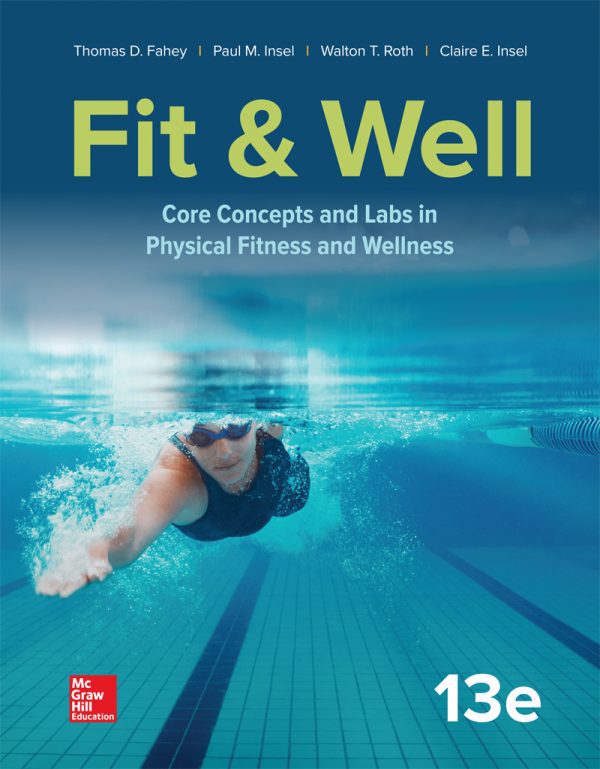Fit Well: Core ConceptsTable of Contents
- Cover
- Title
- Copyright
- Brief Contents
- Contents
- Boxes
- Learn Without Limits
- Proven, Science-Based Content
- What’s New in Fit & Well, 13th Edition
- Your Course, Your Way
- 1 Introduction to Wellness, Fitness, and Lifestyle Management
- Wellness: New Health Goals
- The Dimensions of Wellness
- New Opportunities for Taking Charge
- National Health
- Behaviors That Contribute to Wellness
- Wellness Factors That Seem Outside Our Control
- College Students and Wellness
- Reaching Wellness Through Lifestyle Management
- Getting Serious about Your Health
- Building Motivation to Change
- Enhancing Your Readiness to Change
- Dealing with Relapse
- Developing Skills for Change: Creating a Personalized Plan
- Putting Your Plan into Action
- Staying with It
- Being Fit and Well for Life
- Tips for Today and the Future
- Summary
- For Further Exploration
- Selected Bibliography
- Lab 1.1 Your Wellness Profile
- Lab 1.2 Lifestyle Evaluation
- 2 Principles of Physical Fitness
- Physical Activity and Exercise for Health and Fitness
- Physical Activity on a Continuum
- How Much Physical Activity Is Enough?
- Components of Physical Fitness
- Cardiorespiratory Endurance
- Muscular Strength
- Muscular Endurance
- Flexibility
- Body Composition
- Skill (Neuromuscular)-Related Components of Fitness
- Principles of Physical Training: Adaptation to Stress
- Specificity—Adapting to Type of Training
- Progressive Overload—Adapting to the Amount of Training and the FITT-VP Principle
- Reversibility—Adapting to a Reduction in Training
- Individual Differences—Limits on Adaptability
- Designing your Own Exercise Program
- Getting Medical Clearance
- Assessing Yourself
- Setting Goals
- Choosing Activities for a Balanced Program
- Guidelines for Training
- Tips for Today and the Future
- Summary
- Common Questions Answered
- For Further Exploration
- Selected Bibliography
- Lab 2.1 Safety of Exercise Participation: PAR-Q+
- Lab 2.2 Overcoming Barriers to Being Active
- Lab 2.3 Using a Fitness Tracker or Smartphone Exercise App to Measure Physical Activity
- 3 Cardiorespiratory Endurance
- Basic Physiology of Cardiorespiratory Endurance Exercise
- The Cardiorespiratory System
- Energy Production
- Exercise and the Three Energy Systems
- Benefits of Cardiorespiratory Endurance Exercise
- Improved Cardiorespiratory Functioning
- Improved Cellular Metabolism
- Reduced Risk of Chronic Disease
- Better Control of Body Fat
- Improved Immune Function
- Improved Psychological and Emotional Well-Being
- Assessing Cardiorespiratory Fitness
- Choosing an Assessment Test
- Monitoring Your Heart Rate
- Interpreting Your Score
- Developing a Cardiorespiratory Endurance Program
- Setting Goals
- Applying the FITT-VP Principle
- Warming Up and Cooling Down
- Building Cardiorespiratory Fitness
- Maintaining Cardiorespiratory Fitness
- Exercise Safety and Injury Prevention
- Hot Weather and Heat Stress
- Cold Weather
- Poor Air Quality
- Exercise Injuries
- Summary
- Tips for Today and the Future
- Common Questions Answered
- For Further Exploration
- Selected Bibliography
- Lab 3.1 Assessing Your Current Level of Cardiorespiratory Endurance
- Lab 3.2 Developing an Exercise Program for Cardiorespiratory Endurance
- 4 Muscular Strength and Endurance
- Basic Muscle Physiology and The Effects of Strength Training
- Muscle Fibers
- Motor Units
- Metabolic and Heart Health
- Assessing Muscular Strength and Endurance
- Creating a Successful Strength Training Program
- Static versus Dynamic Strength Training Exercises
- Weight Machines, Free Weights, and Body Weight Exercises
- Other Training Methods and Types of Equipment
- Applying the FITT-VP Principle: Selecting Exercises and Putting Together a Program
- The Warm-Up and Cool-Down
- Getting Started and Making Progress
- More Advanced Strength Training Programs
- Weight Training Safety
- Supplements and Drugs
- Tips for Today and the Future
- Weight Training Exercises
- Common Questions Answered
- Summary
- For Further Exploration
- Selected Bibliography
- Lab 4.1 Assessing Your Current Level of Muscular Strength
- Lab 4.2 Assessing Your Current Level of Muscular Endurance
- Lab 4.3 Designing and Monitoring a Strength Training Program
- 5 Flexibility and Low-Back Health
- Types of Flexibility
- What Determines Flexibility?
- Joint Structure
- Muscle Elasticity and Length
- Nervous System Regulation
- Benefits of Flexibility
- Joint Health
- Prevention of Low-Back Pain and Injuries
- Additional Potential Benefits of Flexibility
- Assessing Flexibility
- Creating a Successful Program to Develop Flexibility
- Applying the FITT-VP Principle
- Making Progress
- Exercises to Improve Flexibility: A Sample Program
- Preventing and Managing Low-Back Pain
- Function and Structure of the Spine
- Core Muscle Fitness
- Causes of Back Pain
- Preventing Low-Back Pain
- Managing Acute Back Pain
- Managing Chronic Back Pain
- Exercises for The Prevention and Management of Low-Back Pain
- Tips for Today and the Future
- Summary
- Common Questions Answered
- For Further Exploration
- Selected Bibliography
- Lab 5.1 Assessing Your Current Level of Flexibility
- Lab 5.2 Creating a Personalized Program for Developing Flexibility
- Lab 5.3 Assessing Muscular Endurance for Low-Back Health
- 6 Body Composition
- What is Body Composition, and Why is it Important?
- Overweight and Obesity Defined
- Prevalence of Overweight and Obesity among Americans
- Excess Body Fat and Wellness
- Problems Associated with Very Low Levels of Body Fat
- Assessing Body Mass Index, Body Composition, and Body Fat Distribution
- Calculating Body Mass Index
- Estimating Percent Body Fat
- Assessing Body Fat Distribution
- Somatotype
- Setting Body Composition Goals
- Making Changes in Body Composition
- Summary
- Tips for Today and the Future
- For Further Exploration
- Common Questions Answered
- Selected Bibliography
- Lab 6.1 Assessing Body Mass Index and Body Composition
- Lab 6.2 Setting Goals for Target Body Weight
- 7 Putting Together a Complete Fitness Program
- Developing a Personal Fitness Plan
- 1. Set Goals
- 2. Select Activities
- 3. Set a Target Frequency, Intensity, and Time (Duration) for Each Activity
- 4. Set Up a System of Mini-Goals and Rewards
- 5. Include Lifestyle Physical Activity and Strategies to Reduce Sedentary Time in Your Program
- 6. Develop Tools for Monitoring Your Progress
- 7. Make a Commitment
- Putting Your Plan Into Action
- Exercise Guidelines for Life Stages and People with Special Health Concerns
- Exercise Guidelines for Life Stages
- Exercise Guidelines for People with Special Health Concerns
- Common Questions Answered
- Summary
- For Further Exploration
- Selected Bibliography
- Sample Programs for Popular Activities
- Lab 7.1 A Personal Fitness Program Plan and Agreement
- Lab 7.2 Getting to Know Your Fitness Facility
- 8 Nutrition
- Nutritional Requirements: Components of a Healthy Diet
- Calories
- Proteins—The Basis of Body Structure
- Fats—Essential in Small Amounts
- Carbohydrates—A Key Source of Energy
- Fiber—A Closer Look
- Vitamins—Organic Micronutrients
- Minerals—Inorganic Micronutrients
- Water—Vital but Often Ignored
- Other Substances in Food
- Nutritional Guidelines: Planning Your Diet
- Dietary Reference Intakes (DRIs)
- Daily Values
- Dietary Guidelines for Americans
- USDA’s MyPlate
- DASH Eating Plan
- The Vegetarian Alternative
- Functional Foods
- Dietary Challenges for Various Population Groups
- Nutritional Planning: Making Informed Choices About Food
- Food Labels
- Calorie Labeling: Restaurants and Vending Machines
- Dietary Supplements
- Food Additives
- Foodborne Illness
- Irradiated Foods
- Environmental Contaminants and Organic Foods
- A Personal Plan
- Assessing and Changing Your Diet
- Staying Committed to a Healthy Diet
- Tips for Today and the Future
- Summary
- For Further Exploration
- Common Questions Answered
- Selected Bibliography
- Lab 8.1 Your Daily Diet versus MyPlate
- Lab 8.2 Dietary Analysis
- Lab 8.3 Informed Food Choices
- 9 Weight Management
- Health Implications of Overweight and Obesity
- Assessing Weight
- Overweight, Obesity, and Specific Health Risks
- Factors Contributing to Excess Body Fat
- Energy Balance
- Genetic Factors
- Physiological Factors
- Lifestyle Factors
- Psychosocial Factors
- Environmental Factors
- Adopting a Healthy Lifestyle for Successful Weight Management
- Dietary Patterns and Eating Habits
- Physical Activity and Exercise
- Thoughts and Emotions
- Coping Strategies
- Approaches to Overcoming a Weight Problem
- Doing It Yourself
- Diet Books
- Dietary Supplements and Diet Aids
- Weight-Loss Programs
- Prescription Drugs for Obesity
- Surgery
- Psychological Help
- Body Image
- Severe Body Image Problems
- Acceptance and Change
- Eating Disorders
- Anorexia Nervosa
- Bulimia Nervosa
- Binge-Eating Disorder
- Other Specified Feeding or Eating Disorders (OSFED)
- Treating Eating Disorders
- Tips for Today and the Future
- Summary
- For Further Exploration
- Common Questions Answered
- Selected Bibliography
- Lab 9.1 Calculating Daily Energy Needs
- Lab 9.2 Identifying Weight-Loss Goals
- Lab 9.3 Checking for Body Image Problems and Eating Disorders
- 10 Stress Management and Sleep
- What is Stress?
- Physical Responses to Stressors
- Psychological and Behavioral Responses to Stressors
- The Stress Experience as a Whole
- Stress and Wellness
- The General Adaptation Syndrome
- Allostatic Load
- Stress and Specific Conditions
- Common Sources of Stress
- Major Life Changes
- Daily Hassles
- College Stressors
- Job-Related Stressors
- Relationships and Stress
- Social Stressors
- Other Stressors
- Managing Stress
- Exercise
- Nutrition
- Social Support
- Communication
- Conflict Resolution
- Striving for Spiritual Wellness
- Confiding in Yourself through Writing
- Time Management
- Cognitive Techniques
- Relaxation and Body Awareness Techniques
- Other Stress-Management Techniques
- Counterproductive Strategies for Coping with Stress
- Getting Help
- Peer Counseling and Support Groups
- Professional Help
- Is It Stress or Something More Serious?
- Sleep
- How Sleep Works: The Physiology of Sleep
- Natural Sleep Drives
- Adequate Sleep and Your Health
- Sleep Disorders
- Improving Sleep
- Tips for Today and the Future
- Common Questions Answered
- Summary
- For Further Exploration
- Selected Bibliography
- Lab 10.1 Identifying Your Stress Level and Key Stressors
- Lab 10.2 Stress-Management Techniques
- Lab 10.3 Evaluating and Improving Sleep
- 11 Cardiovascular Health and Diabetes
- Major Forms of Cardiovascular Disease
- Atherosclerosis
- Heart Disease and Heart Attacks
- Stroke
- Congestive Heart Failure
- Risk Factors for Cardiovascular Disease
- Major Risk Factors That Can Be Changed
- Contributing Risk Factors That Can Be Changed
- Major Risk Factors That Can’t Be Changed
- Possible Risk Factors Currently Being Studied
- Protecting Yourself Against Cardiovascular Disease
- Eat a Heart-Healthy Diet
- Exercise Regularly
- Avoid Tobacco
- Know and Manage Your Blood Pressure
- Know and Manage Your Cholesterol Levels
- Develop Ways to Handle Stress and Anger
- Diabetes
- Types of Diabetes
- Warning Signs and Testing
- Treatment
- Prevention
- Tips for Today and the Future
- Summary
- Common Questions Answered
- For Further Exploration
- Selected Bibliography
- Lab 11.1 Cardiovascular Health
- 12 Cancer
- What is Cancer?
- Tumors
- Metastasis
- Dietary Factors
- The Causes of Cancer
- Tobacco Use
- Obesity and Inactivity
- The Role of DNA
- Race/Ethnicity and Poverty
- Carcinogens in the Environment
- Common Cancers
- Lung Cancer
- Colon and Rectal Cancer
- Breast Cancer
- Prostate Cancer
- Cancers of the Female Reproductive Tract
- Skin Cancer
- Head and Neck Cancers
- Testicular Cancer
- Other Cancers
- Detecting and Treating Cancer
- Detecting Cancer
- Stages of Cancer
- Treating Cancer
- Tips for Today and the Future
- Common Questions Answered
- Summary
- For Further Exploration
- Selected Bibliography
- Lab 12.1 Cancer Prevention
- 13 Substance Use and Misuse
- Addictive Behavior
- How Does an Addiction Develop?
- What Is Substance Misuse and Addiction?
- Examples of Addictive Behaviors
- Psychoactive Drugs
- Who Uses Drugs?
- Opioids and Drug Overdose Deaths
- Other Current Illicit Drugs of Concern
- Treatment for Substance Use Disorder and Addiction
- Preventing Substance Use Disorder
- The Role of Drugs in Your Life
- Alcohol
- Chemistry and Metabolism
- Immediate Effects of Alcohol
- Alcohol Use Disorder: From Mild to Severe
- Effects of Alcohol Use Disorder
- Drinking and Driving
- Binge Drinking
- Drinking and Responsibility
- Tobacco
- Nicotine Addiction
- Health Hazards of Cigarette Smoking
- Risks Associated with Other Forms of Tobacco Use
- Environmental Tobacco Smoke
- Smoking and Pregnancy
- Giving Up Tobacco
- Action Against Tobacco
- Common Questions Answered
- Tips for Today and the Future
- Summary
- For Further Exploration
- Selected Bibliography
- Lab 13.1 Is Alcohol a Problem in Your Life?
- Lab 13.2 For Smokers Only: Why Do You Smoke?
- 14 Sexually Transmitted Infections
- The Major Stis
- STIs and Sexual Anatomy
- HIV Infection and AIDS
- Chlamydia
- Gonorrhea
- Pelvic Inflammatory Disease
- Human Papillomavirus (HPV)
- Genital Herpes
- Hepatitis B
- Syphilis
- Other STIs
- What You Can do about Stis
- Education
- Diagnosis and Treatment
- Prevention
- Tips for Today and the Future
- Summary
- Common Questions Answered
- For Further Exploration
- Selected Bibliography
- Lab 14.1 Behaviors and Attitudes Related to STIs
- 15 Environmental Health
- Environmental Health Defined
- Population Growth and Control
- Factors That Contribute to Population Growth
- How Many People Can the World Hold?
- Air Quality and Pollution
- Air Quality and Smog
- The Greenhouse Effect and Global Warming
- Thinning of the Ozone Layer
- Energy Use and Air Pollution
- Indoor Air Pollution
- Preventing Air Pollution
- Water Quality and Pollution
- Water Contamination and Treatment
- Water Shortages
- Sewage
- Protecting the Water Supply
- SOLID WASTE POLLUTION
- Solid Waste
- Reducing Solid Waste
- Chemical Pollution and Hazardous Waste
- Asbestos
- Lead
- Pesticides
- Mercury
- Other Chemical Pollutants
- Preventing Chemical Pollution
- Radiation Pollution
- Nuclear Weapons and Nuclear Energy
- Medical Uses of Radiation
- Radiation in the Home and Workplace
- Avoiding Radiation
- Noise Pollution
- Common Questions Answered
- Tips for Today and the Future
- Summary
- For Further Exploration
- Selected Bibliography
- Lab 15.1 Environmental Health Checklist
- Appendix A Injury Prevention and Personal Safety
- Appendix B Monitoring Your Progress
- Behavior Change Workbook
- Index
Additional ISBNs: 9781260397130, 1260397130, 9781260155105, 1260155102







Reviews
There are no reviews yet.